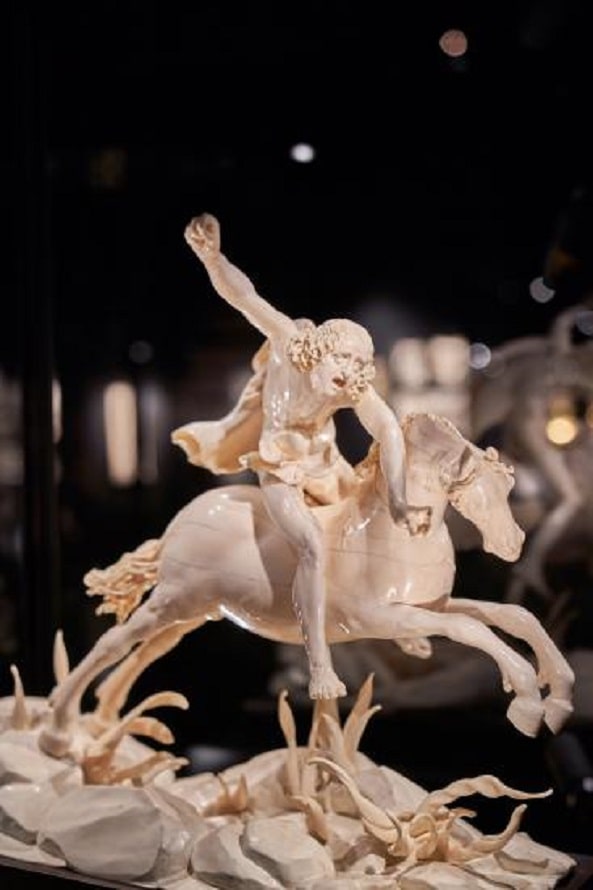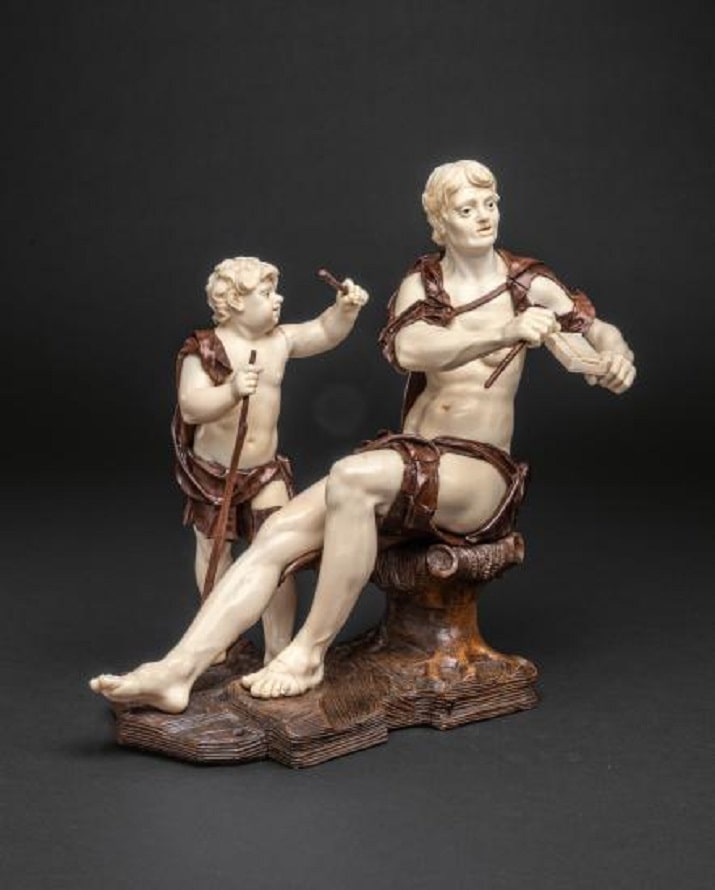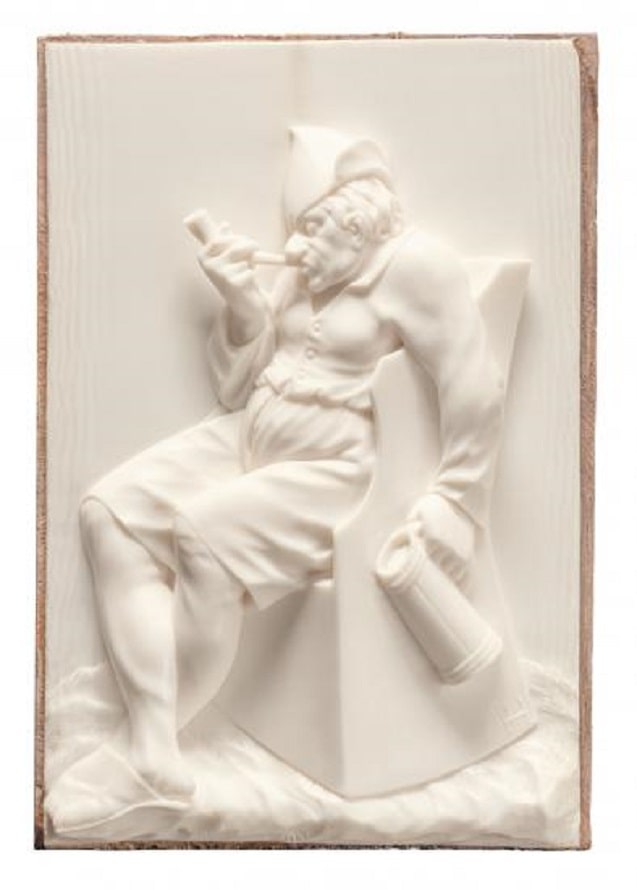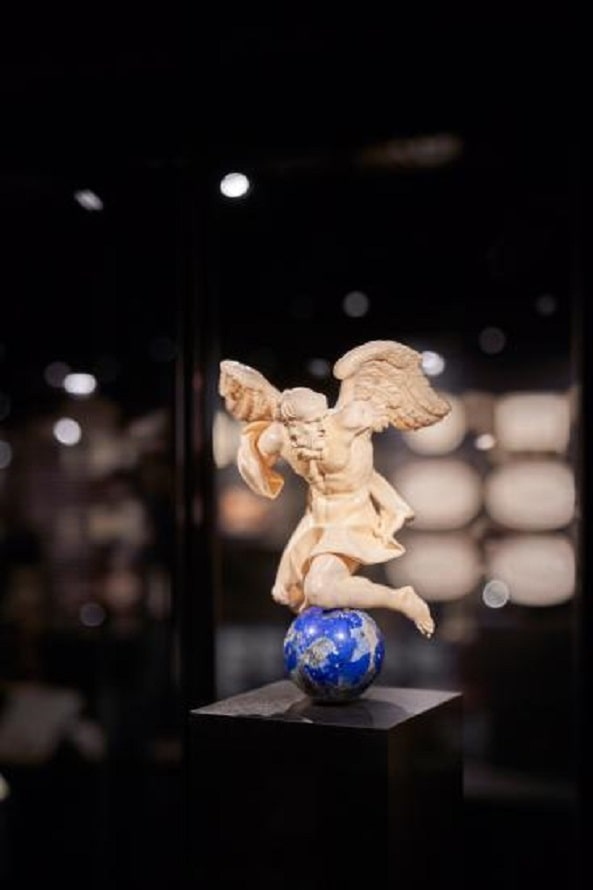From 2 June, the Liebieghaus will be presenting more than 200 precious ivory sculptures of the Baroque and Rococo periods in “Splendid White”.
Image caption: Exhibition view “White Wedding. The Reiner Winkler Ivory Collection now at the Liebieghaus. Forever.”
Frankfurt am Main, 4 May 2022: A few years ago, the Liebieghaus Skulpturensammlung succeeded in acquiring the most important addition to its own holdings in the history of the museum: a collection of precious ivory sculptures of the Baroque and Rococo periods from the estate of the mason Reiner Winkler (1925-2020). The Ernsr von Siemens Kunststifrung, the Sradelsche Museums-Verein and the Sta.del Museum, with the support of the Kulturstiftung der Lander and the Hessische Kulrurstiftung, acquired this unique collection, which was only made possible by the generous donation of the majority of the collection by Reiner Winkler. Since then, masterpieces by world-renowned carvers, such as The Furies Riding a Horse (161 O), The Three Parcenes (c. 1670), Chronos on the Globe (c. 1720/25?) or the Allegory of Damnation in the Virgin {Anima Dannata?) (1736) have been on display at the Liebieghaus under the title “White Wedding”.
With the exhibition and new collection presentation “Splendid Whire”, the Reiner Winkler ivory collection at the Liebieghaus is now complete: from 2 June 2022, more than 200 historical ivory works will be on display – including a further 21 outstanding works of art that remained in the private rooms of the collector Reiner Winkler until his death and are now accessible to the public for the first time. In the new presentation of the collection, the beauty, virtuosity and richness of variation of Baroque ivory carving can be experienced in a fully impressive way. The latest works of art, including portrait medallions, large-format reliefs with Christian and religious motifs and genre scenes, as well as an impressive combination figure, have been installed and hung in the living rooms of the mazes, adding essential exhibits to the previous presentation of the collection in the Liebieghaus. A portrait of the Pope and other large series of stately portraits expand the portraiture section. In addition, the art landscapes of Sízilia and Oieppe as well as the CEuvre of pioneering sculptors and sculptor families, including, for example, Paul Herrmann or the two carvers Carl Augusr Lücke the Elder and the Younger, can be explored. In addition, the close connection of ivory art with exemplary graphic art or folk art becomes clear, whereby cultural-historical connections become more visible.

The donation of the world’s largest private collection of ivory artworks to the Liebieghaus in Frankfurt in 2018 was a high point of the Mazenatentum in the German and international art landscape. Reiner Winkler thus set the tone for the philanthropy for which Frankfurt is renowned and paved the way for the acquisition of his collection – at the same time the most significant expansion of the museum’s holdings in the history of the Liebieghaus. With the exhibition ‘Splendid White’, this unique collection of historical ivory art at the Liebieghaus is now complete. Today, the use of ivory as an artistic material is the subject of controversial discussions and is judged differently. As a museum, we are in a position to conduct scientific research into outstanding works of ivory carving from the Baroque and Rococo periods and to exhibit, classify and communicate them as part of our cultural and historical heritage. With the completion of the Reiner Winkler Collection, a milestone has now been reached in the scholarly cataloguing of historical ivory art,” says Philipp Demandt, Director of the Liebieghaus Skulpturensammlung and the Stadel Museum.
Maraike Bückling, collection manager of the Renaissance to Classicism department and curator of the exhibitions ,,Splendid White” and ,,White Wedding”, adds: “The ivory works from the 17th and 18th centuries, a golden age of ivory art, impress with their viruosity and richness of design as well as their remarkable thematic range. The hardness of the material combined with its elasticity allows for high carving quality with the finest details. Reiner Winkler was also fascinated by aesthetic pleasure and sensual associations. His private collection contained statuettes, groups of figures, reliefs and vessels by important European artists. To have reunited the two parts of Reiner Winkler’s collection, from his ‘Kunstkammer’ and from his living quarters, and to have integrated them into the museum’s holdings is a happy morning for the Liebieghaus.”

The Reiner Winkler Ivory Collection
The collector and mazen Reiner Winkler (1925-2020) created a private collection of ivory sculptures with a focus on Baroque objects over decades of collecting. Winkler built up his collection continuously from 1962 onwards. After a few years of collecting sculptures from different materials and periods, he quickly concentrated entirely on ivory sculptures from the 17th and 18th centuries, and to a very small extent from the early 19th century. Winkler was closely associated with the Liebieghaus Sculpture Collection during his lifetime. He had already made loans to the museum for exhibitions on several occasions. ln the Liebieghaus, his collection has now found “its new and final home” and will thus be “preserved as a ‘Gesamtkunstwerk'”, as Reiner Winkler wished and expressed himself on the occasion of the acquisition in 2019. The unique collection expanded the Liebieghaus’s own internationally important holdings at the highest level. The acquisition also established European ivory art as the central focus of the Liebieghaus’s Baroque and Rococo department – a focus that has since been intensively researched and communicated.
Supported by the Reiner Winkler Foundation, two publications on the Reiner Winkler Ivory Collection are available, “White Wedding” (2019) and “Splendid White” (2022), which illustrate the inventory of the collection and explain the cultural-historical connections between the works of art. The Ernst von Siemens Art Foundation is calling for the presentation of “Splendid White”.
Die Erwerbung der Elfenbein-Sammlung Reiner Winkler konnte durch die Ernst von Siemens Kunststiftung, den Stadelschen Museums-Verein und das Sra.del Museum mir Umerstützung der Kulmrstiftung der Lander und der Hessischen Kulturstiftung sowie privater $penden getatigt werden.
“Splendid White”
In the new exhibition and collection presentation “Splendid White. The Reiner Winkler Ivory Collection at the Liebieghaus”, works of art from the private rooms of Reiner Winkler’s home are now also on display. The collector and mazen lived with these works until his death in 2020 – they are among his earliest acquisitions of historical ivory art.
Portrait medallions and portraits of married couples, noble personalities, private individuals and dignitaries complete the collection presentation with outstanding works, including a portrait of Pope Clement XI (c. 171 O), of which there are at least three versions. In addition to the portrait in the Liebieghaus, two others have survived in the Grünes Gewolbe in Dresden and the V&A in London. They were given to princely converts as gifts from the pope. It can be assumed that the Frankfurt medallion and other versions were made and given away for comparable, as yet unknown, specific occasions. Some of the ivory medallions in the Reiner Winkler Collection, such as the magnificent portraits of the Habsburg imperial couple, Emperor Leopold I and Empress Eleonora Magdalena Theresirl (both c. 1696), can be inserted into series of rulers or princely families. Common features of the series are an extremely tight fit in the high oval, so that hardly any narrow edge remains below the bust section, softly doughy folded moustaches, the design of the lace jabots and the curls by arch-shaped notches as well as the flat hair drawing on the wig edge above the forehead and nose.

In the early 18th century, David Le Marchand created the portrait of Charles Marbury (1704-1720). It is the second portrait and the third work in the collection of Reiner Winl<ler by this Huguenot carver from Dieppe in France. Charles Marbury, of whom only his name and two portraits are known, is shown in profile facing to the right, dressed in a cloak draped around his bust and in a puffed waistcoat. A splendid wig flowing long down his back captivates the observer with its finely streaked hair arranged in numerous curls.
About a generation later, the Lücke family, which probably came from Dresden and is known for its ivory carving, was active: Carl August Lücke d. A. founded the workshop. A. founded the workshop, and his sons Carl August the Younger and Johann Christoph Ludwig continued the tradition. Since 2018, the Liebieghaus has a small group of works by the Lückes. Three further reliefs by Carl August d. A. and d. J., which hung in Reiner Winkler’s living room, now complement this complex of works, which finds seínen climax in the Allegory of the Verd11mmnís in the Hall (Anima Dannata?) (1736), exhibited in ,,White Weddíng”. The extension in 2022 is significant, as up to now only portrait busts of the two artists could be exhibited, but no medallions.
Numerous works in the Reiner Winkler ivory collection depict Christian religious themes. One of the most unusual reliefs is the work St. Maria M11gdalenr1 as a Büferin (1st half of the 17th century), because it is partly polychromed with paint, metal powder and gold leaf and has applications of real jewellery. In composition and figure detail, it is comparable with small devotional pictures in pearwood or boxwood showing half-length figures of saints – for example, with the work St. Catherine with Angel Putto (c. 1600).
Depictions of the Crucified or the Deposition from the Cross have rarely been found in the presentation of the collection. Now there is a large-format depiction of Christ on the cross (2nd half of the 17th century) composed of several parts. At 54 cm high, it is also one of the largest works in the Reiner Winkler Collection and hung for a long time in the Mazen’s study. The carver based his work on an engraving by Francesco Villamena (1606) after a painting by Federico Barocci, which was made between 1567 and 1569 for the Cathedral of San Lorenzo in Perugia.

Among the finest and largest reliefs are the works The Annunciation to Mary and Maria Heirnsuchung (both c. 1770-1780), which for a long time hung in a prominent place in Reiner Winkler’s house. The model for the Annunciation relief is known to be a copper engraving by Laurent Cars after a painting by Frarn;ois Lemoyne. In both reliefs, the sensitively drawn facial features, the slender bodies with delicate limbs and finely styled hair are striking. The figures are surrounded by carefully folded, softly pleated, lined garments. These characteristic features suggest an attribution of the two panels to the Diepper ivory carver Jean-Antoine Belleteste (1731-1811). This adds two extremely important works of art to the section on the artistic landscape of Dieppe in “White Wedding”. The Adoration of the Child by the Shepherds (1st third of the 18th century?) also extends the range of ivory works from southern Icia and Sicily. Sicilian ivory carvers set their ambition to work multi-figured scenes from a piece of elephant tusk; an outstanding example can be seen with the Fall of the Renegade Angels (l. Drircel 18th century) in “White Wedding”.
In the Reiner Winkler Collection, the number of genre scenes is comparatively small, although the subject was also created by ivory carvers such as Johann Christoph Ludwig Lücke, Wilhelm Krüger, Leonhard Kern, by sculptors of combination figures or unknown masters. The works in the Liebieghaus are combination figures and village scenes. Splendid White” presents three new additions: two genre scenes with a tendentious touch, Nodding Man with Pipe and Hurnpen and Sitting Woman with Jug (both l. thrid 18th century), by the Dresden court sculptor Paul Herrmann (1673-1732) as well as a combination figure by Simon Troger (1693-1768). Until the transfer of the Reiner Winl<ler Collection to the Liebieghaus, the museum did not own any of the famous so-called combination figures made of ivory and wood. Since 2019, this genre has been presented in “Whice Wedding” with works of art by Simon Troger, Matthias Kolb and unknown artists. With the combination figure Beggar Woman rnit Saitentarnbourín and Child (1730s) by Sirnon Troger and workshop, the series is impressively extended. Troger specialised in the production of combination figures made of wood, ivory and glass. In particular, the only scantily clad beggar figures and amike god figures in ideal naked rheir offered themselves as a subject area, whereby cosy ivory was used for the unclothed body parts. Remnants of fabric as well as robes were reproduced with noble types of wood. The starting point for Troger’s beggar figures can be seen in other nativity figures, to which the person of the beggar also belonged. The difference is that the cot figures and Troger’s beggar figures in wood and ivory are comparable in size and that they could also be freely combined and put together in different groups. What is striking about the beggars and the nativity figures is that they show strong and muscular bodies.

,,White Wedding”
Since March 2019, the exhibition ,,White Wedding. The Reiner Winkler Ivory Collection now at the Liebieghaus. Forever” presents almost all the pieces from Reiner Winkler’s former so-called “Kunstkammer”. Other ivory works from the Liebieghaus are juxtaposed with those from the Reiner Winkler Collection, and museum exhibits by the same artists, but made of different materials, are also shown.
On the basis of the exhibits, the history of small sculpture in the Baroque and Rococo periods is vividly traced in thematic chapters. Some masterpieces from the Reiner Winkler Collection will be highlighted, for example the central work The Furie Blasting Horse (161 O) by the so-called Furienmeiser (active around 1600-1625). The following works will also be on display: Joachim Henne’s Die drei Parzen (c. 1670), Francis van Bossuit’s Mercury, Argus and Jo (c. 1670/75?), the relief panels carved by an unknown Augsburg sculptor Minerva Attributes Sculpture and Painting to the Seven Liberal Arts (2nd half of 17th century) and the depiction of Eight Principal Virtues (2nd half of 17th century). Other works include Matthias Sreinl’s Chronos on the globe (c. 1720/25?), the allegory of damnation in the Holle (Anima Dannata?) (1736) by Johann Christoph Ludwig Lücke and the Stui-z of the renegade angels (1st third of the 18th century) carved by an ivory artist in southern Italy or Sicily whose name is not yet known.)
Germany and Óscerreich, for example, played an extremely important role in ivory art, which is evident in the Reiner Winkler collection. For this reason, important artists such as Leonhard Kern (1588-1662), Georg Fründt (1603-1663), Jacob Dobbermann (1682-1745), the Lücke family of artists or Johann Caspar Schenck (c. 1620-1674) and his younger relative Christoph Daniel Schenck (1633-1691) receive their own chapters in “Whice Wedding”. One section unites miccelalcer works; depictions of saints as well as works that convey biblical content form a group. Works dedicated to anric themes and those created by important court or chamber sculptors are also presented in a concentrated manner. In addition, three artistic landscapes are presented: the Netherlands, southern Italy/Sicily and Dieppe.
WHERE?
Liebieghaus Skulpturensammlung
Schaumainkai 71
60596 Frankfurt am Main.
WHEN?
Saturday, 2 June 2022 to Sunday, 8 January 2023
COST?
10 euros, additional 8 euros, free admission for children under 12 years of age






